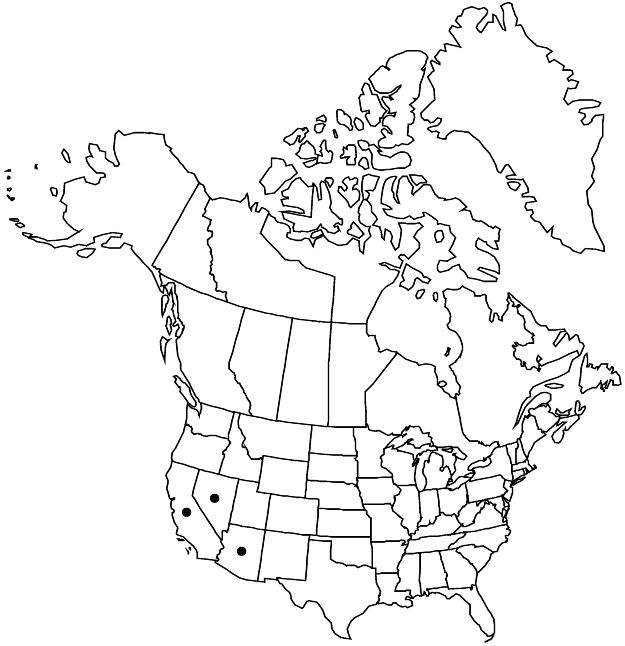Difference between revisions of "Petalonyx thurberi"
Pl. Nov. Thurb., 319. 1854.
FNA>Volume Importer |
RevisionBot (talk | contribs) m (Bot: Adding category Revised Since Print) |
||
| (4 intermediate revisions by 3 users not shown) | |||
| Line 20: | Line 20: | ||
-->{{Treatment/Body | -->{{Treatment/Body | ||
| − | |distribution= | + | |distribution=Ariz.;Calif.;Nev.;n Mexico. |
|discussion=<p>Subspecies 2 (2 in the flora).</p><!-- | |discussion=<p>Subspecies 2 (2 in the flora).</p><!-- | ||
--><p>W. S. Davis and H. J. Thompson (1967) called attention to geographical variation in <i>Petalonyx thurberi</i> and distinguished <i></i>subsp.<i> gilmanii</i>, which is restricted to washes in Inyo County, California, from the widespread <i></i>subsp.<i> thurberi</i>. Subspecies gilmanii has flowers on the small side of those found among other populations of <i>P. thurberi</i>, although floral attributes do not readily distinguish between the two named subspecies. Davis and Thompson also noted another form that has relatively small leaves on and closely appressed to the inflorescence-bearing stems, although they did not formally distinguish this variant with a name. Morphometric and phylogeographic studies are warranted in <i>P. thurberi</i> to test whether morphological variation is significant, geographically partitioned, and associated with genetically isolated lineages.</p> | --><p>W. S. Davis and H. J. Thompson (1967) called attention to geographical variation in <i>Petalonyx thurberi</i> and distinguished <i></i>subsp.<i> gilmanii</i>, which is restricted to washes in Inyo County, California, from the widespread <i></i>subsp.<i> thurberi</i>. Subspecies gilmanii has flowers on the small side of those found among other populations of <i>P. thurberi</i>, although floral attributes do not readily distinguish between the two named subspecies. Davis and Thompson also noted another form that has relatively small leaves on and closely appressed to the inflorescence-bearing stems, although they did not formally distinguish this variant with a name. Morphometric and phylogeographic studies are warranted in <i>P. thurberi</i> to test whether morphological variation is significant, geographically partitioned, and associated with genetically isolated lineages.</p> | ||
| Line 51: | Line 51: | ||
|basionyms= | |basionyms= | ||
|family=Loasaceae | |family=Loasaceae | ||
| − | |distribution= | + | |distribution=Ariz.;Calif.;Nev.;n Mexico. |
|reference=None | |reference=None | ||
|publication title=Pl. Nov. Thurb., | |publication title=Pl. Nov. Thurb., | ||
|publication year=1854 | |publication year=1854 | ||
|special status= | |special status= | ||
| − | |source xml=https:// | + | |source xml=https://bitbucket.org/aafc-mbb/fna-data-curation/src/2e0870ddd59836b60bcf96646a41e87ea5a5943a/coarse_grained_fna_xml/V12/V12_192.xml |
|genus=Petalonyx | |genus=Petalonyx | ||
|species=Petalonyx thurberi | |species=Petalonyx thurberi | ||
}}<!-- | }}<!-- | ||
| − | -->[[Category:Treatment]][[Category:Petalonyx]] | + | --> |
| + | |||
| + | [[Category:Treatment]] | ||
| + | [[Category:Petalonyx]] | ||
| + | [[Category:Revised Since Print]] | ||
Latest revision as of 18:11, 6 November 2020
Shrubs, bushy to moundlike, to 10 dm; branches of current season 12–45 cm. Leaves: petiole absent; blade ovate to elliptic, with marked size dimorphism, to 45 × 15 mm, much larger on main stems than on fertile branches, base acute to rounded, margins usually serrate or crenate, distal often entire, apex acute. Inflorescences to 40-flowered. Flowers conspicuously bilaterally symmetric; petals spatulate, to 6.5 mm, claws postgenitally distally coherent, forming slitted corolla tube; stamens exserted laterally through slits between petal claws. 2n = 46.
Distribution

Ariz., Calif., Nev., n Mexico.
Discussion
Subspecies 2 (2 in the flora).
W. S. Davis and H. J. Thompson (1967) called attention to geographical variation in Petalonyx thurberi and distinguished subsp. gilmanii, which is restricted to washes in Inyo County, California, from the widespread subsp. thurberi. Subspecies gilmanii has flowers on the small side of those found among other populations of P. thurberi, although floral attributes do not readily distinguish between the two named subspecies. Davis and Thompson also noted another form that has relatively small leaves on and closely appressed to the inflorescence-bearing stems, although they did not formally distinguish this variant with a name. Morphometric and phylogeographic studies are warranted in P. thurberi to test whether morphological variation is significant, geographically partitioned, and associated with genetically isolated lineages.
Selected References
None.
Key
| 1 | Hairs on inflorescence-bearing stems ± retrorse. | Petalonyx thurberi subsp. thurberi |
| 1 | Hairs on inflorescence-bearing stems ± erect. | Petalonyx thurberi subsp. gilmanii |